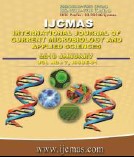


 National Academy of Agricultural Sciences (NAAS)
National Academy of Agricultural Sciences (NAAS)

|
PRINT ISSN : 2319-7692
Online ISSN : 2319-7706 Issues : 12 per year Publisher : Excellent Publishers Email : editorijcmas@gmail.com / submit@ijcmas.com Editor-in-chief: Dr.M.Prakash Index Copernicus ICV 2018: 95.39 NAAS RATING 2020: 5.38 |
The frontline demonstrations (FLD’s) on BRG-5 variety of pigeon pea were conducted by Krishi Vigyan Kendra of Ramanagara District, Karnataka State. Initially farm trials of BRG-5 variety were conducted during 2012-13 and was released by University of Agricultural Sciences, Bengaluru during 2014-15, which is resistant to wilt. Improved cultivation practices were demonstrated in farmer’s fields for three consecutive years. The results of the demonstrations showed higher yields compared to traditional farmer’s practices followed for pigeon pea cultivation. The average increased per cent seed yield is 38.47 over the years from front line demonstrations compared to check plots. However, during the year 2015-16, the per cent increase in seed yield was 65.42. The huge variation in the per cent increase in the yield was due to scanty rainfall and major variations in farmer’s practices adopted in the cluster villages. The other parameters like extension gap, technological gap and technology index were derived for assessment of technology adoption rate. The average technology gap and technological index were 6.08 and 33.72 per cent, respectively. The results clearly indicated the positive impact of front line demonstrations over the farmers’ practices towards enhancing the productivity of pigeon pea cultivation under rainfed conditions in Ramanagara district of Karnataka state, India. Demonstrated technologies proved more remunerative and economically feasible compared to farmers traditional practices in pigeon pea cultivation.
 |
 |
 |
 |
 |